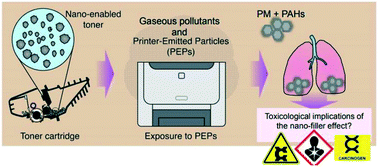Abstract
Recent studies have shown that engineered nanoparticles (ENPs) are incorporated into toner powder used in printing equipment and released during their use. Thus, understanding the functional and structural composition and the potential synergistic effects of this complex aerosol and released gaseous co-pollutants is critical in assessing their potential toxicological implications and risks. In this study, toner powder and PEPs were thoroughly examined for the functional and molecular composition of the organic fraction and the concentration profile of 16 Environmental Protection Agency (EPA)-priority polycyclic aromatic hydrocarbons (PAH) using state-of-the-art analytical methods. Results show significant differences in abundance of the non-exchangeable organic hydrogen of toner powder and PEPs, with a stronger aromatic spectral signature in PEPs. Changes in the structural composition of PEPs are indicative of radical additions and free-radical polymerization favored by catalytic reactions, resulting in formation of functionalized organic species. Particularly, accumulation of aromatic carbons with strong styrene-like molecular signatures on PEPs is associated with formation of semi-volatile heavier aromatic species (i.e., PAHs). Further, the transformation of low molecular weight PAHs in the toner powder to high molecular weight PAHs in PEPs was documented and quantified. This may be a result of synergistic effects from catalytic metal/metal oxide ENPs incorporated into the toner and the presence/release of semi-volatile organic species (SVOCs). The presence of known carcinogenic PAHs on PEPs raises public health concerns and warrants further toxicological assessment.
Article provided by Environmental Science: Nano


